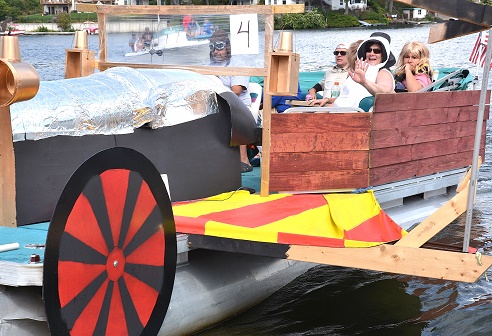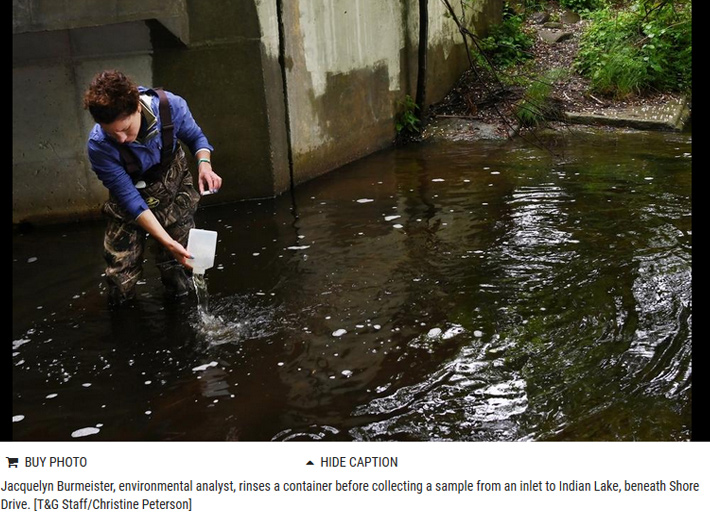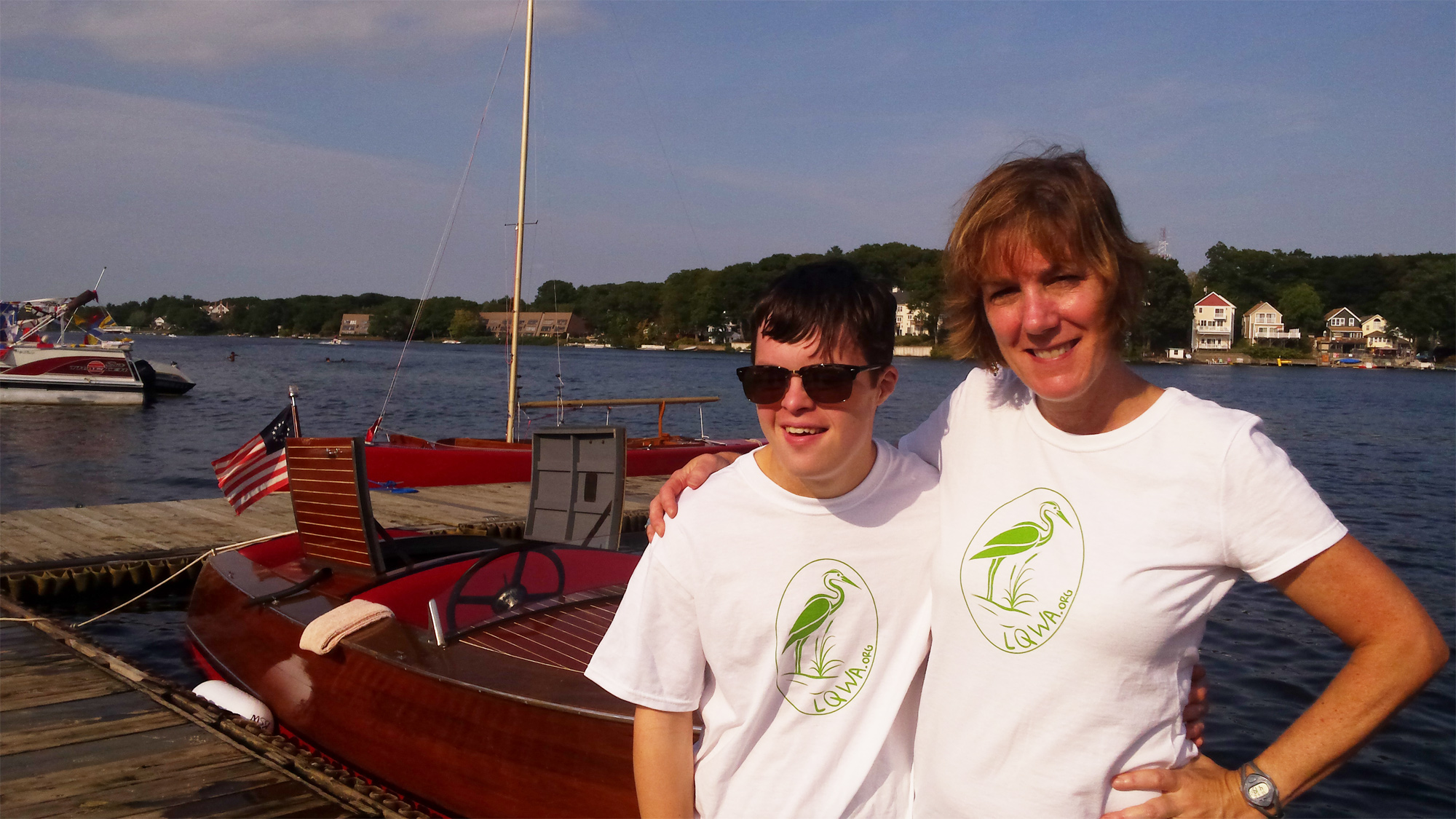WORCESTER – Water was coming from all directions Tuesday morning: splashing over the bow of the 8-foot boat; falling in a cold, light rain; and sampled from approximately 15 feet beneath the surface of Indian Lake.
“The idea is we want to get a sense of the water going into the lake, the outflow, and in the middle of the lake,” said Jacquelyn Burmeister, city of Worcester environmental analyst, as she sampled water at an earlier location. “It’s one piece of a bigger research program to identify the stressors to the lakes and ponds in Worcester.”
Worcester’s waterways fueled the city’s industrial growth and flushed its urban pollution for years. But with the passage of the Clean Water Act and the work of local environmentalists, the lakes and ponds have rebounded.
But while improved, the lakes and ponds are not pristine. Today’s water quality problems have largely changed from effluent-belching pipes, however, to invasive plants that crowd out native species, cloudy water that decreases photosynthesis and oxygen levels in a water body, and excess nutrients that can prompt toxic algal blooms that close a water body to use.
“It’s a shift from industrial contamination to water quality issues from a more urbanized environment,” said Ms. Burmeister, noting that the issues are not unique to Worcester.
But what is unique to Worcester is that the city is taking action.
Ms. Burmeister was hired last fall as part of a new program in the city’s water operations division called the Lakes and Ponds Program. The goal of the program is to keep the quality of water in the city’s lakes and ponds swimmable and usable for recreation and in a manner that promotes economic development.
“The endgame of all of this is to better manage these (water bodies) so that they’re incredible assets to an urban area,” said Philip D. Guerin, the city’s director of water and sewer operations. “We’re trying to keep them at or improve them to the point where they are even more valuable.”
The $150,000 city-funded program was prompted by an increasing awareness that Worcester’s lakes and ponds play an important role in the quality of life in the city.
Community and neighborhood groups have largely advocated and cared for the city’s lakes and ponds for decades. But a few events began sparking discussion at the city government level about the health and future of the waterways.
As the idea of a Boston Olympics was promoted, city leaders pushed for Lake Quinsigamond as a rowing venue. A bloom of toxic cyanobacteria shut down Indian Lake in the summer of 2014. Most recently, Mayor Joseph M. Petty announced a Blue Spaces Initiative in January 2016 that seeks to promote and protect the city’s waterways and lakes on par with the city’s green spaces.
“These spaces are recreational, environmental, and economic assets that need to be opened up for public enjoyment and development,” said Mr. Petty.
But while there was perhaps lots of interest and attention being paid to the health of the lakes, there wasn’t necessarily a lot of data about what’s happening in the lakes.
That’s where the boat comes in.
Twice a week, Ms. Burmeister samples water, measuring such indicators as pH, temperature, the amount of oxygen in the water, and nitrogen and phosphorus – nutrients that can lead to harmful algal blooms. She samples tributaries coming into and out of four major water bodies – Lake Quinsigamond, Coes Reservoir, Bell Pond and Indian Lake – as well as water at the surface and bottom of the water bodies themselves. Each water body is sampled twice a month. (The city also samples water at the beaches for harmful bacteria, Mr. Guerin noted.)
The idea is to get a baseline of data so that the health of the lakes and the water coming into and out of them can be studied over time. The testing is also preventative. Certain conditions such as warm weather, lots of sunlight, and excess nutrients in the water can precede harmful algal blooms, and the hope is that a symptom can be identified, treated, and alleviated before a bloom occurs. The city is also testing for cyanobacteria at Indian Lake with a contractor.
The city plans to post the data in an online digital commons.
But the Lakes and Ponds program involves more than just water sampling. It also involves public education.
Wednesday night at the Knights of Columbus hall on the shores of Coes Reservoir, about 30 people gathered for a presentation on the steps that homeowners can take to improve water quality.
“We have a huge opportunity as citizens and homeowners to really make a difference in our waterways,” Stefanie Covino, project coordinator of the Shaping the Future of Your Community Program of Massachusetts Audubon Society, told the attendees.
Ms. Burmeister began the presentation with an overview of the threats facing the city’s waterways. She primarily focused on two: excess nutrients in the waterways, and turbidity – or the cloudiness or opacity of the water because of suspended materials in the water column.
Excess nutrients in the waterway can lead to harmful algal blooms, which gobble up oxygen in the water, suffocating fish and other animals, Ms. Burmeister explained. The algae die and release toxins that can be harmful to humans. Turbidity – which can be a result of algal blooms, runoff of sediments, or erosion – prevents sunlight from penetrating the water, decreasing plants’ photosynthesis and also decreasing the amount of oxygen. Algal blooms are also aesthetically unpleasant; as the algae can smell and cover the water in a film the color of pea soup.
To prevent these two threats, residents learned about everything from how to construct a rain garden to the importance of picking up pet waste.
“I didn’t realize the global issues coming down to the impact of my little yard,” said Columbus Park resident Barbara Engwall. “It is a good opportunity for Worcester residents to learn. It should be in all neighborhoods.”
A group of neighbors from Patch Reservoir planned to relay the information on building rain gardens to their own watershed group.
“Part of our goal is not only preserving the lake … but to spread the word as to how to help,” said Michele Aubin, a member of the Friends of Patch Reservoir.
Ms. Burmeister and members of the Environmental Protection Agency and Department of Environmental Protection have also organized training sessions for residents to learn how to identify cyanobacteria, or blue-green algae, the algae that shut down Indian Lake in 2014.
The residents will be examining water samples once a month to look for the algae. The first training will be held June 17, Ms. Burmeister said.
“By using this method, it will allow us to try and keep an eye on the water bodies and what’s going on with them before a potential problem gets going,” said Beth Proko, president of the Indian Lake Watershed Association.
Ms. Proko praised the city for the Lakes and Ponds Program.
“This program has really been a dream come true in my eyes,” Ms. Proko said. “To have somebody that’s a focal point, working for the city… it is instrumental to us as an organization … (Ms. Burmeister’s) really stepped forward and found different ways that we can work together and share resources, and I think that this is the tip of the iceberg as far as making progress to restore our local waterways.”

 General Findings: This month ( August 2017), in addition to the Anabaena and Microcystis that we have seen over the beginning portion of the summer, we discovered another genus of cyanobacteria in Lake Quinsigamond. This one is called Woronichinia, which can form clusters like Microcystis. It is known to shoot out the individual cells, making the inside look hallow under the microscope at times.
General Findings: This month ( August 2017), in addition to the Anabaena and Microcystis that we have seen over the beginning portion of the summer, we discovered another genus of cyanobacteria in Lake Quinsigamond. This one is called Woronichinia, which can form clusters like Microcystis. It is known to shoot out the individual cells, making the inside look hallow under the microscope at times.










